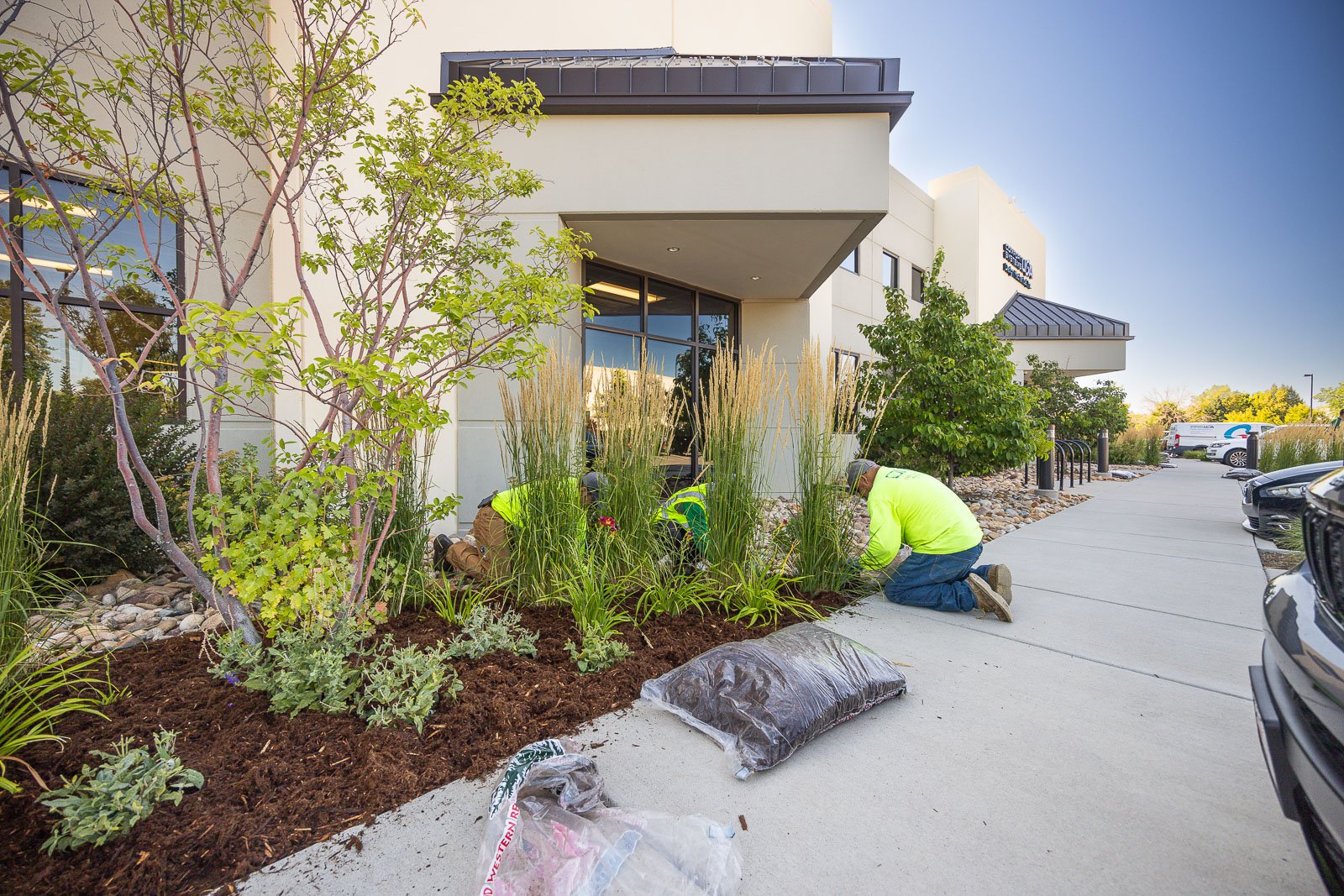
Your Guide for Using Native Plants for Your Boulder Commercial Landscape

As a property manager in Boulder, CO tasked with maintaining lush landscapes in our distinctive climate, you may be asking yourself how to balance aesthetic appeal with sustainability and cost-effectiveness.
With our region’s hot summers, cold winters, and limited precipitation, finding plants that thrive can be challenging.
Landscaping with Colorado’s native plants might just be your solution.
Let’s explore native plant landscaping, the advantages of natives in a commercial setting, and some creative ideas when landscaping with Colorado native plants so you can enhance your commercial landscape in both an economical and eco-friendly way.
Understanding Native Plant Landscaping
Native plants are defined as species that have evolved naturally in a particular region over thousands of years. They are well-adapted to local soil, climate, and environmental conditions.
In Boulder, this means selecting plants that thrive in the semi-arid climate of the Front Range, characterized by hot summers, cold winters, and low annual precipitation.

Advantages of Native Plants at Your Boulder, CO Landscape
Landscaping with Colorado native plants offers numerous benefits that go beyond just aesthetic appeal. Embracing plants indigenous to the region not only enhances the natural beauty of your landscape but also promotes ecological sustainability and resilience. Let’s look at several benefits to including native plants at your commercial property:
Environmental Advantages
The most popular use for native plantings in Boulder is water efficiency. Native plants are inherently adapted to local water conditions, requiring minimal irrigation once established. This helps reduce water consumption significantly compared to non-native species, making them ideal for Boulder’s arid climate where water conservation is crucial.
Native plant landscaping also provides essential habitat and food sources for local wildlife, including birds, butterflies, and other pollinators. They contribute to biodiversity and help maintain ecological balance in both urban and suburban landscapes.
Choosing native planting landscaping for your commercial landscape supports the broader environmental goals we in Boulder value.

Economic Advantages
What makes a landscape with native plants great for the environment also helps you to manage your budget effectively. As native plants generally need less water than traditional ones, they help to control your water usage budget.
Boulder experiences temperature fluctuations and occasional droughts. Native plants have evolved mechanisms to survive these extremes, making them more resilient and less susceptible to damage compared to non-native species. They can tolerate the heat and dry spells we experience and do not necessarily die if there happens to be an irrigation issue. They stand a much better chance of surviving our harsh winters with extensive snow piles and weight. The resilience of native plants helps to reduce plant replacement costs.
Because they are adapted to local conditions, native plants generally require less maintenance, such as pruning and fertilizing. They are more resistant to pests and diseases, reducing the need for chemical treatment. Removing spent blooms and some pruning are the largest upkeep tasks for most natives. This reduced landscape maintenance means fewer expenditures need to be dedicated to plant maintenance.

Aesthetic Advantages
Native plants offer several aesthetic advantages that contribute to the beauty of commercial landscapes as well. They enhance the natural beauty of the Boulder area with their unique forms, colors, and textures that blend harmoniously with the surroundings.
Many native plants bloom seasonally, offering bursts of color throughout the year. Both their foliage and flowers often change with the seasons, providing dynamic visual interest.

Planning Your Landscape with Native Plants
When planning to design with native plants, it is important to first review the planting restrictions your HOA, business park, or even city or county may have on which plants can be used on commercial properties. It is critical this information is obtained before any planning begins.
Native plants can be incorporated into existing landscapes and planting beds. They can also be used to create special areas on your commercial property like a pollinator garden or rain garden. Create visual interest and ecological benefits by incorporating plants with different heights, textures, and bloom times. Mix perennials, shrubs, and grasses to create a dynamic and resilient native landscape.
When in the initial planning stages, be sure to consider that native plants typically perform best with drip irrigation because water is delivered directly to the root zone of plants, minimizing evaporation and water waste.
Finally, when landscaping with native Colorado plants identify native plants that thrive in Boulder’s specific climate and soil conditions. While there are several varieties to choose from these five are our favorites: when landscaping with native colorado plants

- May Night Purple Salvia
This hardy perennial is known for its striking purple-blue flowers that bloom from late Spring to early summer. It typically grows about 18-24 inches tall and spreads to 12-18 inches wide. This is a great native choice as Salvia thrives in full sun to part shade.
- Purple Coneflower
The coneflower, or Echinacea, is one of the most popular native perennials. While the coneflower comes in a variety of colors, the purple variety is known for its string purple-pink daisy-like flowers surrounding a spiky orange-brown cone. Coneflower can tolerate drought and poor soil conditions once established. They typically bloom from early to late summer.
- Russian Sage
This shrub-like perennial is known for its beautiful silvery-gray foliage and tall spikes of lavender-blue flowers. It is a great choice for Boulder as it thrives in hot, dry climates. Both low-maintenance and deer- resistant, it blooms from mid-summer to early Fall.
- Koreanspice Viburnum
Koreanspice Viburnum is a decidous shrub known for its dark green, glossy leves that turn shades of red and purple in the fall. It also has fragrant flowers that bloom in clusters in early to mid-spring. This native can thrive in full sun to part shade and is relatively low-maintenance once established.
- Shademaster Honeylocust
This popular deciduous tree is best known for its gracefully, spreading canopy and delicate fern-like foliage. The Honeylocust is a popular choice because its tolerance of a wide range of soil conditions and ability to thrive in urban environments.
Partnering with a Commercial Landscaping Contractor for Native Plant Landscaping
Native plants are not only well-adapted to our local soil and weather conditions but also offer numerous benefits that go beyond just their natural beauty.
At LID Landscapes, we excel in incorporating native plants into commercial properties, ensuring they both flourish and enhance your landscape’s attractiveness while reducing maintenance needs and costs. Our expertise can help you create a vibrant and eco-friendly environment that aligns with Boulder’s environmental goals and enhances your property’s value.
Whether it’s designing a pollinator garden, integrating drought-tolerant species, or enhancing biodiversity, our team at LID can make your landscaping vision a reality with native Colorado plants.
Ready to enhance your commercial landscape with native plantings? Fill out our contact form and get started with an account manager today.

Scott Natter
